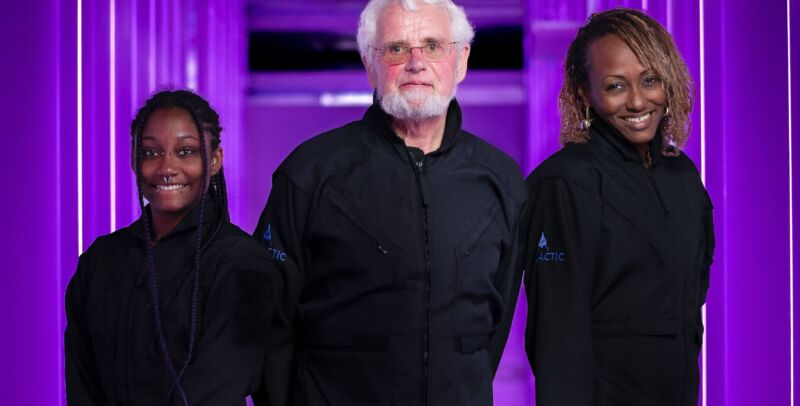
SPACEPORT AMERICA, New Mexico—On Thursday morning, Virgin Galactic plans to fly private citizens into space for the first time.
The company's VSS Unity spacecraft is due to be released from its carrier aircraft after 9 am local time (15:00 UTC), and it will then rocket above an altitude of 80 km. The vehicle will carry two pilots (CJ Sturckow and Kelly Latimer), company representative Beth Moses, and three private customers.
The private astronauts are an interesting mix. They include the company's first paying customer, an 80-year-old named Jon Goodwin, who competed for Great Britain in the 1972 Munich Olympics as a canoeist. He is joined by Keisha Schahaff and Anastatia Mayers, a Caribbean mother-daughter duo whose tickets were purchased by the nonprofit Space for Humanity in order to broaden access to space.
This will be Virgin Galactic's seventh spaceflight and second commercial spaceflight. Its first commercial flight, on May 25, carried three members of the Italian Air Force.
The spacecraft will take off attached to a large carrier aircraft, the VMS Eve, and the vehicles will spend nearly an hour reaching the drop altitude of 47,000 feet (a bit higher than 14 km). About 10 minutes before the spacecraft is released, it will switch to internal power.
What the ride is like
The drop is not actually a "drop," per se. Because the aircraft and spacecraft have roughly the same mass, when Eve releases Unity it climbs rapidly due to the sharp decrease in its weight. Unity, meanwhile, continues flying more or less horizontally.
After the aircraft is clear, Unity will ignite its rocket engine and burn for about 60 seconds. The first 10 seconds or so will involve horizontal acceleration before the vehicle's pilots pitch upward to a nearly vertical attitude, flying straight through the top of the atmosphere. People on board will experience about 3 Gs of force.
Unity and its passengers will then enjoy about three minutes of weightlessness while coasting up to an altitude between 80 and 85 km, and then they will begin their descent. During this phase of flight, there are no forces acting on the vehicle, no movement by the spacecraft, and no noise. It must be a really magical moment to be floating freely above the world, looking down and looking up.
The return to Earth takes about 15 minutes, during which Unity acts largely as a glider, returning to the three-mile long runway in southern New Mexico from which its carrier aircraft took off little more than an hour earlier.
Starting at 9 am Mountain Time (15:00 UTC), Virgin Galactic will host a livestream of the flight. Ars will be on hand for the mission and will provide a full recap afterward, along with an in-depth look at how the company plans to eventually make money from the commercial space tourism industry.


/cloudfront-us-east-2.images.arcpublishing.com/reuters/H4QBQNUBMVM75EUB3NMZF4AMNM.jpg)
3175x175(CURRENT).thumb.jpg.b05acc060982b36f5891ba728e6d953c.jpg)

Recommended Comments
There are no comments to display.
Join the conversation
You can post now and register later. If you have an account, sign in now to post with your account.
Note: Your post will require moderator approval before it will be visible.